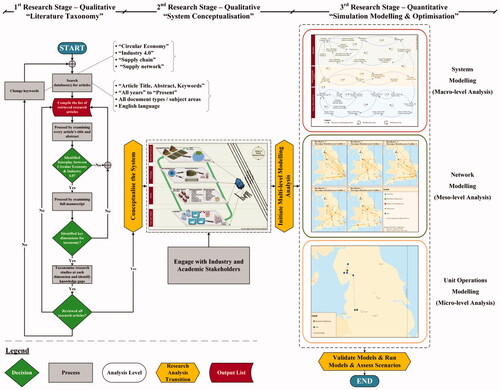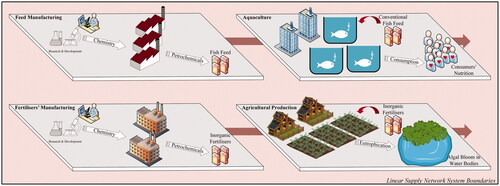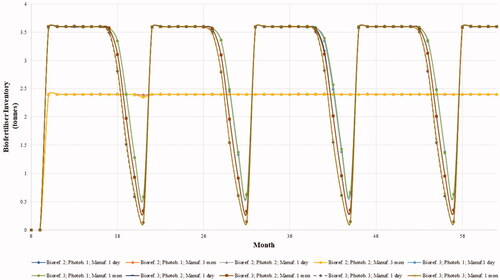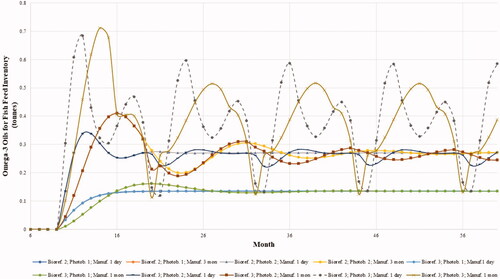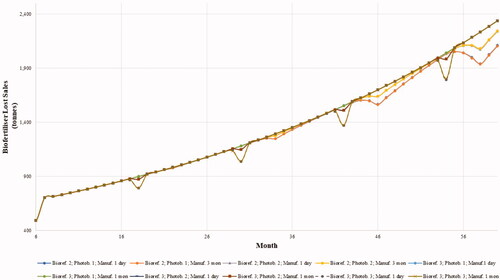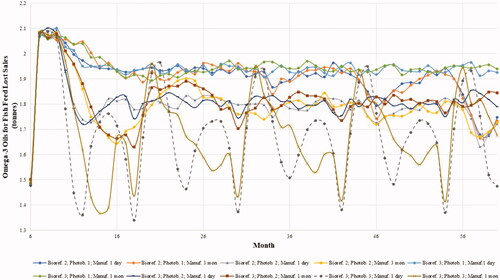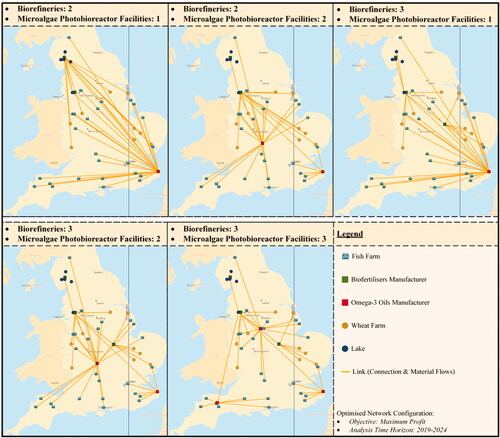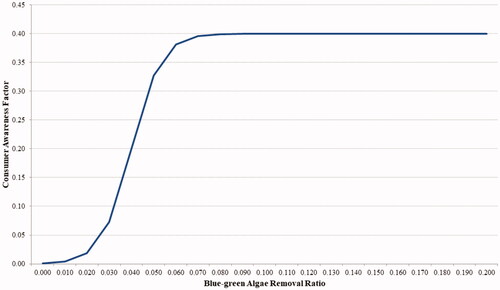Abstract
This research introduces the idea of ‘Circular Economy 4.0’ to reflect the emergence of ‘digitalised’ sustainable supply networks. While often characterised by enhanced productivity and resource/energy efficiency, current perspectives are largely descriptive with limited practical relevance. A hierarchical decision-making framework and a multi-level simulation modelling and optimisation technique are constructed to explore the interplay between Circular Supply Chains and Industry 4.0. The real-world case of blue-green algae as renewable feedstock – to derive value-added omega-3 oils and biofertilisers – is investigated to develop ‘Circular Economy 4.0’ perspectives. The emerging circular supply network utilises micro-factories (i.e., photobioreactors), continuous manufacturing technologies (i.e., piezoelectric transducers), and drone operations for feedstock availability monitoring. This study contributes to theory and practice by building on the limited empirical research exploring determinants of successful transitions in Circular Economy-Industry 4.0 network contexts. Four design principles are proposed that capture the interplay between digital technologies and network design configurations, e.g., centralised – semi-centralised – decentralised. Modelling is developed across macro-, meso-, and micro-levels of analysis. Results demonstrate significant gains in terms of resources utilisation and market dynamics, enabled by the adoption of digital operations in a circular economy context, with initial insights on the evolution of such networks.
1. Introduction
Sustainability pressures along with on-going radical advancements in digital technologies are driving the establishment of value-added production and consumption systems (de Sousa Jabbour, Jabbour, Foropon, et al. Citation2018), in which the circularity of energy and material flows could promote economic growth, environmental stewardship and social benefits (Geissdoerfer et al. Citation2017). In particular, the need for circular supply network operations is prominent to generate greater resilience to climate change (Ellen MacArthur Foundation Citation2019), specifically considering the: (i) rising demand for finite natural resources (Calvo, Valero, and Valero Citation2017); (ii) often-improper management of significant end-of-life product volumes (Sivakumar et al. Citation2018); and (iii) projections indicating that middle-class consumers will increase by three billion globally by 2030 (World Economic Forum Citation2014). To this end, Industry 4.0 has the potential to unlock Circular Economy dynamics across industrial supply networks in a cost-effective and sustainable manner (de Sousa Jabbour, Jabbour, Filho, et al. Citation2018), through enabling: (i) higher level of connectivity among actors and smart equipment, real-time data monitoring, and human-machine interaction for operational efficiency (Yang et al. Citation2018); (ii) automated wastage collection, sorting, treatment and processing for production efficiency (Nascimento et al. Citation2019); and (iii) increased information processing capability and transparency for uninterrupted logistics/information flows (Bag et al. Citation2020).
Policy-makers, academics and industry stakeholders are exploring the expected benefits that might arise from the integrated application of Circular Economy operational models and Industry 4.0 principles in manufacturing networks (Lin Citation2018). This interplay is also encouraged by the United Nations in the context of the 2030 Agenda for Sustainable Development (United Nations Citation2015), while the Ellen MacArthur Foundation (Citation2015) stressed the enabling role of investments in digital technologies with regards to fostering the transition towards Circular Economy paradigms. Industry-wise, digital manufacturing technologies are now considered sufficiently mature to support Circular Economy value propositions to enable operations excellence (Lieder and Rashid Citation2016), for example, in terms of optimised material stock and flows (Srai et al. Citation2016). In this regard, the Operations Management literature is being populated by analysis frameworks and assessment tools which aim to either facilitate the configuration of circular supply chains (Srai et al. Citation2018), or promote the integration of technological innovations in supporting sustainability in value networks (Bechtsis et al. Citation2018).
Nevertheless, research investigating the interplay between Circular Economy and Industry 4.0 is still embryonic (de Sousa Jabbour, Jabbour, Filho, et al. Citation2018); notably, Nobre and Tavares (Citation2017) presented bibliometric data for the period 2006–2015 demonstrating the sparsity of scientific studies jointly examining these topics. Specifically, the authors reported that less than 0.25% of the reviewed Circular Economy-focussed studies considered digital technologies while the detachment between scientific research and industrial applications was also evident. More recently, Tseng et al. (Citation2018) identified only three relevant published articles studying the nexus of these topics. Existing studies mainly provide a descriptive perspective of the link between Circular Economy and Industry 4.0 while myopically discussing the implications of digitalisation in the lifecycle management of products and processes (Rosa et al. Citation2020). Also, extant research on capturing the causal relations between Circular Economy and digital technologies from a systems perspective is scant (Luthra et al. Citation2018), while the documented operationalisation of Industry 4.0 in Circular Economy applications is nascent (Kouhizadeh, Zhu, and Sarkis Citation2020). Moreover, practical challenges relating to the digitalisation of supply chains for circular operations are also overlooked in studies conducted to date (Fatorachian and Kazemi Citation2018). Hence, the current literature is inadequate in informing relevant business strategies and in fostering the deployment of smart manufacturing networks that might be more environmentally friendly, flexible and economical (Luthra and Mangla Citation2018). To this effect, further case-based studies and additional empirical research is required to inform the management of circular supply chain operations enabled by Industry 4.0 for supporting sustainability, including productivity improvements, waste reduction, resource use efficiency, remanufacturing, reusing, and recycling. By extension, and potentially to a greater extent, is the need for the application of decision-making tools that could assist organisations in making informed and more effective a priori evaluations of sustainable supply networks’ designs (Allaoui et al. Citation2018).
Industry 4.0 is deemed an enabler of end-to-end circular supply networks, principally with regard to the classical ‘3R’ concept (i.e., reuse, recycle, remanufacture) that is closely related to Circular Economy (Nobre and Tavares Citation2017). Documented circular supply chain and digital manufacturing paradigms include the exploitation of citrus waste to produce active pharmaceutical ingredients (Lapkin et al. Citation2017), and the utilisation of smart cells for remanufacturing carburised steel shafts (Yang et al. Citation2018). However, a knowledge gap exists with regards to the operationalisation of the synergy between circular supply chain strategies and Industry 4.0. This research – in investigating the case of renewable feedstock platform technologies – contributes to the Operations Management domain by enhancing the understanding of the relationship and interplay between circular supply networks and Industry 4.0. More specifically, this study demonstrates emerging and innovative operational capabilities within the discussed setting by addressing the following research questions (RQs):
RQ#1 – How might the interplay between Circular Economy and Industry 4.0 be best represented, in enabling ‘real-world’ transitions to sustainable supply chains?
RQ#2 – Which major hierarchical decision-making determinants best support the adoption of Industry 4.0 applications, in enabling the configuration of circular supply network operations?
RQ#3 – How does the digitalisation of operations affect the configurational design and performance of the aforementioned circular supply networks?
Motivated by the study of Fatorachian and Kazemi (Citation2018) and building upon the research agenda proposed by de Sousa Jabbour, Jabbour, Filho, et al. (Citation2018), we introduced a conceptual framework to address RQ#1. The framework depicts the rotary co-action of Circular Economy and Industry 4.0 as the ‘backbone’ towards the transition to circular supply networks. With specific drivers and goals, the proposed framework particularly focuses on the real-world case of the valorisation of blue-green algae into biofertilisers for food crop farms and omega-3 oils for fish feed in the UK. The response to RQ#2 identified the hierarchical decision-making process that applies to all stakeholders involved in the design and management of circular supply chains enabled by digital technologies. Simulation modelling and optimisation assessments were utilised to investigate the impact of digital manufacturing and renewable feedstock monitoring systems on circular supply chain operations in an attempt to address RQ#3.
This research followed a mixed-methods approach to answer all three questions. In particular, a synthesis of Circular Economy and Industry 4.0 research evidence was conducted to address RQ#1. Thereafter, a critical taxonomy of studies in the extant literature was utilised to answer RQ#2. Finally, a multi-level simulation modelling and optimisation analysis approach yielded robust and informative results which assisted in answering RQ#3 and revealed directions for future research.
The remainder of this paper is structured as follows: Section 2 presents the background underpinning this research, while Section 3 outlines the relevant materials and methods. Section 4 identifies the natural hierarchy of the decision-making process for the design and management of circular supply networks enabled by Industry 4.0 applications. Section 5 then composes a multi-level simulation modelling and optimisation approach that captures impacts of digitalisation on the configuration and performance of circular supply networks. The application of the proposed framework is demonstrated for the UK case with the modelling results and discussion presented in Section 6. Finally, Section 7 concludes this research and highlights implications, limitations and suggestions for future research.
2. Research background
2.1. Circular Economy and Industry 4.0
The literature investigating Industry 4.0-driven sustainable supply network operations is rather limited. Jensen and Remmen (Citation2017) discussed the role of information exchange interfaces in supporting product stewardship throughout the life cycle of industrial products in manufacturing industries (e.g., automobile, aircraft and shipping) to promote the transition towards circular economy whilst ensuring information security and confidentiality. Additionally, Tseng et al. (Citation2018) discussed the role of Big Data and the Internet of Things (IoT) in fostering industrial symbiosis under the umbrella of Circular Economy. The authors identified related gaps that prevent the implementation of ‘3R’ strategies across industrial networks, further supporting the lack of integrated Industry 4.0 solutions – in end-to-end supply chains – as the main challenge in applying Circular Economy models. Furthermore, Bressanelli et al. (Citation2018) identified eight functionalities enabled by IoT and Big Data analytics and studied the associated impact on the drivers of Circular Economy through a case study on a household appliances retailer. An original roadmap for the interplay between Circular Economy and Industry 4.0 was discussed by de Sousa Jabbour, Jabbour, Filho, et al. (Citation2018), which specifically highlighted the value of digital manufacturing technologies in applying the ReSOLVE business model.
The need for leveraging digital technologies to migrate towards Circular Economy paradigms is specifically pronounced for the chemical industry as the sector mainly relies on petrochemical feedstocks. Projections show an anticipated increase in demand for chemicals of circa 45% during the next decade (ExxonMobil Citation2015). Hence, the exploitation of sustainable chemical feedstocks for the engineering of commercial products, typically petrochemical-based, is highly advocated as in the case of plastics manufactured from plant-derived lignocellulosic biomass (Artz and Palkovits Citation2018), or in the ‘green’ paracetamol paradigm produced from either citrus waste or waste from Kraft paper and pulp industries (Tsolakis and Srai Citation2018).
The benefits of digitalisation and automation for the chemical industry, in a sustainability context, are well recognised by research and business communities. From an academic perspective, Industry 4.0 technologies are expected to promote industrial sustainability through enabling chemical process integration, production modularity and real-time decentralised decision-making (Kamble, Gunasekaran, and Gawankar Citation2018). Furthermore, business experts recognise the potential of Industry 4.0 in supporting sustainable chemical supply chain planning and scheduling decisions owing to (Van Thienen et al. Citation2016): (i) inherent technological capabilities of improved end-to-end supply networks visibility; and (ii) advanced data gathering mechanisms and supply chain analytics that lead to better-informed demand forecasting.
2.2. Theoretical lens
The embodiment of Circular Economy principles in traditional supply chain design and management has strategic, structural and scoping implications that impact the transition towards real-world circular supply networks (De Angelis, Howard, and Miemczyk Citation2018). In addition, Industry 4.0 is documented to impact supply chain management by improving material flows, information sharing, coordination and integration (Dallasega, Rauch, and Linder Citation2018).
In this research, we adopted the view of Srai et al. (Citation2018) who identified four theme areas of analysis for configuring circular supply networks enabled by renewable feedstocks, namely: (i) feedstock; (ii) technology; (iii) market; and (iv) value and viability. Notably, we view circular supply chains as networks where discarded material is being collected, processed and utilised as input to establish value networks in diverse industries (Tsolakis, Kumar, and Srai Citation2016). From an Industry 4.0 perspective, we considered the ‘Sustainable Supply Chain Cube’, proposed by Bechtsis et al. (Citation2017), which captures the triple-helix sustainability implications of intelligent vehicles in logistics. To this effect, the proposed mechanism that captures the interplay and combined rotary effect of Circular Economy and Industry 4.0 for achieving sustainable supply network operations is presented in .
Figure 1. Framework capturing the transition towards sustainable supply networks, empowered by the interplay between Circular Economy and Industry 4.0.

Whereas a typical supply chain is a linear network of suppliers, manufacturers, markets and end-consumers, we argue here that the sustainability transition mechanism of such traditional networks may be ‘motorised’ by the two ‘wheels’ of Circular Economy and Industry 4.0. On one end, the Circular Economy ‘wheel’ consists of the four theme areas of analysis suggested by Srai et al. (Citation2018), i.e., ‘renewable feedstock – technology – market – value and viability’, which is specifically attributable to supply chains enabled by renewable feedstocks. It is essential to consider the macro-level dynamics across the feedstock, technology, market, and value and viability theme areas to identify required interventions within the Circular Economy space (e.g., reuse, recycle, remanufacture). On the other end, leveraging Industry 4.0 in manufacturing systems requires a set of strategic, tactical and operational decisions (Marques et al. Citation2017). Furthermore, as a range of intelligent autonomous systems are able to perform a spectrum of supply chain processes, decision-making at the execution level is a key component of the Industry 4.0 ‘wheel’ (Bechtsis et al. Citation2017). The rotation of the Industry 4.0 ‘wheel’ enables data monitoring and gathering to accordingly automate operations and promote innovation from an end-to-end network perspective. Finally, the interplay between the Circular Economy and Industry 4.0 ‘wheels’ to mobilise the transition towards sustainable supply chain operations necessitates awareness of the industrial system and how this may be influenced by internal and external drivers such as institutional trends, industrial developments and firm level strategies (Harrington and Srai Citation2012).
Our proposed framework differentiates itself from the roadmap proposed by de Sousa Jabbour, Jabbour, Filho, et al. (Citation2018) in that we exemplify the synergistic effect of Circular Economy and Industry 4.0 sustainability transition powers, and we further integrate these in a supply chain context. However, both studies share the common vision of driving sustainable operations management.
3. Materials and methods
The rationale of using a mixed-methods approach is to achieve a greater understanding of complex supply chain management phenomena by combining qualitative and quantitative research evidence (Lyons, Um, and Sharifi Citation2020). The basic terminology and research approach relevant to this study are detailed in subsections 3.1 and 3.2, respectively.
3.1. Basic terminology
Considering that the focus of this research is the interplay between Circular Economy and Industry 4.0, it is essential to define these terms in the context in which they are employed. Thereafter, the idea of ‘Circular Economy 4.0’, introduced in this research, is defined.
3.1.1. Circular Economy
The Circular Economy paradigm, which has attracted interest in both political circles and in the research and practitioner literature, emphasises the application of reuse, recycle and remanufacture to manage waste, extend products’ life cycle, and support economic growth (Mangla, Luthra, Mishra, et al. Citation2018). The European Commission posited that: ‘In a circular economy the value of products and materials is maintained for as long as possible; waste and resource use are minimised, and resources are kept within the economy when a product has reached the end of its life, to be used again and again to create further value’ (EC Citation2015).
In this research, as the emphasis is on the circularity of renewable feedstocks, a circular supply network is defined as a chain of operations that aims to exploit naturally occurring substances, e.g., algae as a renewable feedstock, in order to derive value-added chemicals with commercial applications in diversified industries. In this bio-based context, Industry 4.0 is regarded as the set of enabling technologies for the ‘… efficient utilisation of inexpensive and renewable resources for the production of target compounds’ (Zhang, Babtie, and Stephanopoulos Citation2012, p.360).
3.1.2. Industry 4.0
The current fourth industrial revolution discourse, propagating amongst global academic and industrial agendas, is firmly positioned within the manufacturing realm (Liao et al. Citation2017). Furthermore, an associated key theme is that digitalisation can promote more efficient, agile and customer-focussed industrial supply networks (Xu, Xu, and Li Citation2018). Hence, research and practice efforts focus on supporting the transition towards a ‘smarter’ manufacturing landscape which can been characterised by enhanced production responsiveness, economic viability and environmental sustainability (Wang et al. Citation2016). Representative proposals constituting the fourth industrial revolution often tend to be differently positioned, i.e., ‘Industrie 4.0’ in Germany, ‘Industrial Internet’ in the US, or ‘Factories of the Future’ in the European Union. Herein, the term ‘Industry 4.0’ is adopted owing to its popularity in the academic literature (Liao et al. Citation2017).
Despite the plethora of ‘labels’ attributed to Industry 4.0, according to Hofmann and Rüsch (Citation2017), the underlining notion is common: to leverage the interplay among cyber systems, information sharing technologies, and physical systems to enable industrial value creation at product design, production, distribution, consumption and disposal levels. The multi-echelon implications of Industry 4.0 provide the potential for unravelling sustainable value creation in end-to-end industrial supply networks (Luthra and Mangla Citation2018).
According to Stock et al. (Citation2018), the basic Industry 4.0 technologies include: (i) cyber-physical systems; (ii) cloud computing; and (iii) digital twins and digital shadows, where a combination of these technologies may enable sustainable development. At an operational level, this research complements this list of technologies with the assertion that sensory-driven intelligent vehicles could be used for monitoring feedstocks or executing hazardous manual tasks for evidence-based decision-making (Bechtsis et al. Citation2018).
3.1.3. Circular Economy 4.0
Building on the descriptions outlined in subsections 3.1.1 and 3.1.2, this research introduces the term ‘Circular Economy 4.0’. In the context of our real-world demonstrator case, we propose a pertinent definition as follows:
Circular Economy 4.0 is the design, analysis and management of circular economy-focused operations enabled by Industry 4.0 technologies, in order to efficiently utilise renewable feedstocks for promoting sustainability and configuring value-added manufacturing networks.
3.2. Research approach
This research integrates qualitative and quantitative evidence to generate valid arguments in the Operations Management domain. In this regard, the object of scrutiny is both primary and secondary research. Specifically, three research stages were elaborated, namely: (i) literature taxonomy; (ii) system conceptualisation; and (iii) simulation modelling and optimisation. The methodology flowchart underpinning this research is depicted in .
3.2.1. Literature taxonomy
As one of the objectives of this research is to identify a major hierarchical decision-making framework that supports the adoption of Industry 4.0 applications in configuring circular supply networks, we synthesised knowledge from the existing literature. To ensure scientific integrity, we taxonomised articles retrieved from the ScopusⓇ and Web of ScienceⓇ databases as these catalogue a broad range of peer-reviewed journals in the Natural Sciences and Engineering fields (Mongeon and Paul-Hus Citation2016). To identify peer-reviewed articles jointly investigating Circular Economy and Industry 4.0, we performed Boolean searches using appropriate keywords. In particular, the terms ‘circular economy’, ‘circular’ and ‘industry 4.0’ were searched either separately or in combination with the terms ‘supply chain’ and ‘supply network’. We selected the ‘Article Title, Abstract, Keywords’ category in ScopusⓇ and the ‘Topic’ category in Web of ScienceⓇ while the timespan was set from ‘All years’ to ‘Present’ in both databases. The collected articles were then accepted or rejected in terms of further review based on their content. Our analysis was limited to journal articles written in English; we identified a limited number of papers written in German which were excluded from our taxonomy. Pertinent references cited in the reviewed articles were used as supplementary secondary sources.
As of the 19th of February 2020, a total of sixteen articles jointly investigating Circular Economy and Industry 4.0 were identified. Relevant studies are being published since 2017 and the increasing number of recent article publications highlights the nascent character and emerging interest in the topic. Notably, almost all the reviewed articles were published in different journals, thus indicating the novel, yet inclusive, nature of this research domain. The allocation of the reviewed publications by journal and year is summarised in .
Table 1. Published articles by journal and year.
summarises the main elements of the reviewed literature. The vast majority of the reviewed studies are limited to a critical discussion about the opportunities, challenges and barriers associated with the joint analysis of Circular Economy and Industry 4.0. This indicates a lack of real-world case studies exploring the actual impact of the synergistic application of the two principles in the context of sustainable supply chain management. Moreover, the examined case studies are limited to very brief discussions on project intentions or pilot projects, without actually demonstrating any real-world implications. Regarding the discussed enabling technologies, these are limited to Big Data and IoT, further demonstrating that researchers conceptualise the utilisation potential of cyber-physical systems without considering technical details or functional specifications at an operational level.
Table 2. Critical taxonomy of the existing literature.
3.2.2. Simulation modelling and optimisation
In order to pragmatically demonstrate the interplay between Circular Economy and Industry 4.0, we applied a multi-level simulation modelling and optimisation approach. The multi-level modelling approach allows researchers to attain higher flexibility in capturing supply chain operations, depending on the level of abstraction, while contemporarily harnessing the advantages of every utilised method (Wang, Brême, and Moon Citation2014). In particular, the overall modelling approach was developed across three levels of analysis based on Srai et al. (Citation2017), to investigate the enabling role of Industry 4.0 with regard to upstream and downstream circular network operations, namely: (i) macro-level analysis – modelling and simulating the market-demand dynamics and the overall behaviour of the digital-enabled circular supply system; (ii) meso-level analysis – modelling the emerging supply network structure and optimising its configuration based on economic efficiency; and (iii) micro-level analysis – optimising the routing of an autonomous agent informing the scheduling of supply chain operations. Specifically, at the micro-level, the unit of analysis was considered to be an autonomous vehicle, as opposed to a manufacturing process or plant (Srai et al. Citation2017). The modelling approach was developed under different Industry 4.0 technology scenarios to demonstrate the interplay between the circularity of renewable feedstocks and digital applications at different levels of analysis.
At the macro-level, the market-demand dynamics of the considered circular supply system were modelled and simulated by leveraging the System Dynamics principles. The methodology has been used to model complex systems by capturing the causalities and feedback mechanisms that determine the dynamic behaviour of industrial networks (Sterman Citation2000). The structural elements of System Dynamics are the causal loops and the stocks and flows that render the methodology appropriate for strategic decision-making (Tsolakis and Anthopoulos Citation2015). In particular, causal loops refer to directed arrows among parameters and variables of a system denoted by either a positive (‘+’) polarity (i.e., the effect changes accordingly to the cause – reinforcing feedback, R) or a negative (‘−’) polarity (i.e., the effect changes reversely to the cause – balancing feedback, B). System Dynamics is also recommended as a mapping methodology for investigating industrial network systems enabled by renewable feedstocks, and has been specifically used in the case of ‘green’ pharmaceuticals produced from naturally occurring or wasted terpenoid compounds (Tsolakis and Srai Citation2018).
At the meso-level, the configuration of the considered circular supply network is operationalised by determining production capacities and locations of manufacturing sites as well as the underpinning material flows. The simulation of a supply network’s behaviour in discrete time can then inform tactical and operational decision-making (Chatfield, Harrison, and Hayya Citation2006). Finally, at the micro-level, the optimal routing of an unmanned aerial vehicle (also known as drone) – used to monitor the status of renewable feedstock sources – was calculated.
3.2.3. Modelling validation and verification
Modelling validation and verification are essential for simulation-based studies to ensure the reliability of the provided outputs (Swisher et al. Citation2001). Validation examines whether the ‘right model’ was formulated (Balci Citation1998), while verification determines whether the modeller developed the ‘model right’ (Banks et al. Citation2009).
The proposed System Dynamics simulation model was validated and verified based on tests described by Sterman (Citation2000). In terms of validation, typical tests were applied including the logical interpretation of the attained results, the rational behaviour of the system against different sensitivity analysis scenarios, and the extreme-condition tests. All authors counter-examined the model to verify its structural consistency and avoid possible unintentional changes in the input parameters. Furthermore, the simulation component of the software tool Supply Chain Guru® was used to validate the optimal supply network designs in addition to the routing of the drone (Manataki, Chen-Burger, and Rovatsos Citation2014).
4. Critical taxonomy
The resulting hierarchical decision-making framework demonstrates the multi-faceted and complex nature of circular supply network operations enabled by Industry 4.0 applications. presents a synopsis of the identified decisions along with the supporting research. A key expectation from Industry 4.0 is the higher level of material flows’ monitoring across supply chains; however, at an operational level digitalisation benefits are attributed to the functional characteristics of the used equipment/machinery.
Table 3. Critical taxonomy of the extant research studies.
5. Real-world demonstrator case
The interplay between Circular Economy and Industry 4.0 is demonstrated using the real-world challenge of blue-green algae bloom growth in major lakes across the UK. These blooms – which can be toxic for people, animals and plants – typically develop during the spring period and only decline at the onset of winter conditions (Moorhouse et al. Citation2018). The main UK locations that encounter the blue-green algae issue are Windermere, Ullswater, Coniston Water, Killington Reservoir and Pennington Flash (UK Environment Agency Citation2018). The hazardous effect is attributed to the presence of microcystins, a family of chemically stable cyclic hepatotoxins produced by cyanobacteria (Bourne et al. Citation2006). At the same time, algae sludge is a rich source of organic nutrients with the associated protein content being nearly 62% of the total solids (Zhong et al. Citation2012); however, the commercial potential of this protein source remains unexploited. Typically, the disposal of algal sludge retrieved from inland water bodies is unstructured, further resulting in severe secondary environmental pollution (Yan et al. Citation2012).
To this end, the circular exploitation of algae biomass for synthesising value-added intermediates or end-products, e.g., biofertilisers and omega-3 oils as feed additives in fish farms, could promote the triple-helix of sustainability. However, the key research challenge is the lack of robust approaches that could be applied for investigating the design transformations (e.g., centralised – semi-centralised – decentralised configurations) and performance assessment of emerging circular supply systems enabled by the interplay with Industry 4.0 implementations.
Traditionally, linear supply networks exploit natural resources and utilise virgin raw material as inputs, in a ‘take-make-dispose’ mode of operations, with significant environmental, economic and social ramifications (Nasir et al. Citation2017). captures the parallel structure and unsustainable nature of a linear supply network system of operations for the production of conventional fertilisers and fish feed.
From a circular economy viewpoint, algal sludge constitutes a valuable renewable feedstock source for circular supply network operations to provide: (i) low-cost high-quality biofertilisers, as it is a nutrient-rich candidate for the solid-state fermentation of plant growth-promoting rhizobacteria (Zhang et al. Citation2014); and (ii) premium-price high-purity omega-3 oils, to be used as feed supplement in salmon fish farms, to ultimately deliver elevated levels of omega-3 long-chain fatty acids intake to humans (Shepherd, Monroig, and Tocher Citation2017).
Soil degradation is a major challenge for the UK agriculture with estimated annual costs ranging between £0.9 and 1.4 billion (Graves et al. Citation2015), which can be mainly attributed (47%) to the loss of organic carbon in the soil. In this regard, the use of inorganic fertilisers and nutrient runoff phenomena from agricultural fields to water bodies has contributed to the degradation of the high or good quality status of the UK surface water bodies from 36% in 2012 to 35% in 2017 (Joint Nature Conservation Committee Citation2018). For significant crops grown in the UK, like wheat which is cultivated on 1.7 million hectares (Department for Environment and Food and Rural Affairs Citation2018), the use of algae-based fertilisers could help replace overused volumes of chemical fertilisers and pesticides while returning carbon and nutrients to the soil. The application of algae-based biofertilisers alleviates eutrophication in water bodies due to the reduced use of nitrogen and phosphorus, while algae is further circulated as a value-added input to agricultural farms thus mitigating the magnitude of the algal bloom phenomenon (Zhang et al. Citation2014).
In addition, the international market for omega-3 oils was valued at US$33 billion in 2016, demonstrating strong growth in recent years with a compound annual growth rate of over 14%, while projections point to a market value of US$57 billion in 2025 (Statista Citation2017). Algae is a fundamental source of omega-3 fatty acids (e.g., eicosapentaenoic and docosahexaenoic acids) which constitute major nutritional elements for fish and seafood used to satisfy human dietary and nutritional needs (Stiles et al. Citation2018). However, these long-chain acids are not available via commercial protein substitutes (e.g., soybeans, pea seeds, corn gluten). The co-production of diverse products is proven to benefit both the sustainability of algae-based platform technologies and the economics of their respective manufacturing supply networks (Soto-Sierra, Stoykova, and Nikolov Citation2018). Therefore, the transition towards sustainable supply chains may be empowered by the interplay between Circular Economy and Industry 4.0, as demonstrated in . The automation hierarchy underpinning the Industry 4.0 application, towards establishing operationally efficient and sustainable value networks, was adopted by Bechtsis et al. (Citation2018).
Figure 4. Circular system structure of biofertilisers and omega-3 oils for fish feed supply networks enabled by Industry 4.0.
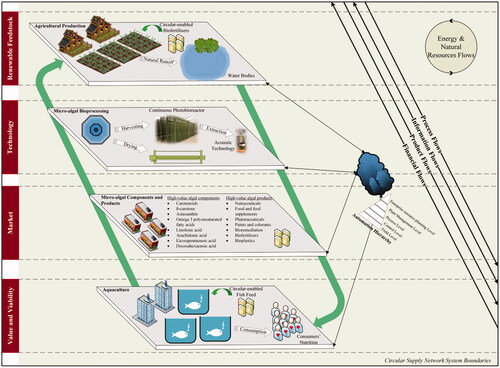
5.1. Case description
We consider a circular supply network system that valorises blue-green algae, collected from targeted UK lakes, into biofertilisers for wheat farms and omega-3 oils for fish feed. Along with the renewable feedstock source echelon, the stages of manufacturing and retailing/consumption are also considered. Operations at the wholesaling echelon are not captured as the wholesalers are also regarded as retailers/consumers.
From an Industry 4.0 perspective, considering the geographical area of each of the identified UK lakes along with the recursive nature, variant duration and intensity of the algal bloom phenomenon, we assumed the use of a drone as a representative digital application for monitoring the targeted surface water bodies. In this sense, drone-enabled inspection allows the real-time monitoring of algae bloom growth to timely inform the effective planning and scheduling of harvesting operations at the collocated biofertilisers manufacturing plants. Following the biofertiliser formulation, extracted high-quality microalgae strains are transported to a number of distributed manufacturing facilities equipped with indoor closed-loop photobioreactors in cylindric shape for the continuous cultivation of microalgae strains to produce high-quality health-promoting ingredients (Pankratz et al. Citation2017). An Industry 4.0 application in these facilities is represented by the use of piezoelectric transducers to assist microalgal cell membrane lysis for the downstream biodegradation of biomass for high-value bioactive component extraction (Struckas et al. Citation2017). The sensors-enabled continuous manufacturing process in the distributed micro-factories enables enhanced agility when compared with the dominant centralised batch manufacturing technology.
We assume that the required synthesis pathways for algae-based biofertilisers, along with the acoustic extraction technology of omega-3 oils from microalgae, are applied at an industrial-scale level. Regulations about the safe exploitation of blue-green algae for biofertilisers and omega-3 oils for feed are also assumed to be flexible, in a similar fashion to end-to-end digital demonstrators (facilitated by pre-competitive consortia in the pharmaceuticals sector) that are not constrained by current regulations (Harrington, Joglekar, and Srai Citation2018). The system and network model descriptions are detailed in Appendix I.
5.2. Model development
Model development at the macro-, meso- and micro-levels is underpinned by the same secondary data. However, the structure of the models along with the elaborated data are different, considering the nature of the simulation modelling approaches performed at each level of analysis.
The intense algal bloom phenomenon in the identified lakes can generally be considered to be seasonal, appearing from June to September on an annual basis (Binding et al. Citation2018). The area of the five targeted water bodies in the UK, which were severally affected by possibly toxic algal blooms in the summer of 2018 (Pinkstone Citation2018), were: (i) Windermere, area: 1,473 ha; (ii) Ullswater, area: 890 ha; (iii) Coniston Water, area: 470 ha; (iv) Killington Reservoir, area: 57 ha; and (v) Pennington Flash, area: 70 ha. We considered that the algal sludge was accumulated over the total lake surface area of 2,960 ha. As drones can inform in real-time about the progression of the blue-green algal bloom phenomenon, we incorporated a function capturing the delay of the transmitted information to commence circular supply chain operations with a smoothing factor equal to 1/30 (i.e., the delay in receiving the information is equal to a day). We assume that – on average − 60% of the collected blue-green algae biomass is exploitable due to physico-chemical specifications. The natural drying period of the collected blue-green algae biomass, to reduce moisture content, was assumed 7 days (Hu et al. Citation2013). The average algae biomass extraction rate was selected to be 7.7 kg/ha (Branigan Citation2008) with a volatile matter factor of 70.13% (Hu et al. Citation2013).
Furthermore, we assumed that the collected algae biomass from the lakes is transported to nearby manufacturing plants for the production of biofertilisers, a high-volume and low-value product; according to Tripathi et al. (Citation2008), microalgae inoculants in biofertilisers replace about 25–30% of standard nitrogen content. We assumed an annual biofertilisers production capacity per plant of 18 tonnes, with a typical utilisation rate of 80%. We further considered that the demand for nitrogen (as a fertiliser nutrient) in the UK was 1,026 thousand tonnes in 2015/2016, with an average growth rate of 2.3% during the last decade (AIC Statistics Citation2017). The share of biofertilisers in the total nitrogen-based fertilisers market accounts for about 10% (Bio-FIT Citation2017). We also consider a safety stock period for the manufactured biofertilisers of 2 months.
During biofertilisers production, high-quality microalgae strains are isolated, collected and transported to a network of distributed digital micro-factories enabled by indoor multi photo-stage photobioreactors for the continuous, industrial scale cultivation of the selected microalgae strains. The microalgae cultivation is followed by the continuous extraction of omega-3 oils for fish feed, a low-volume and high-value product. Specifically, we assumed a photobioreactor capacity of 10,000 L and a maximum microalgae growth rate of 0.52 g/L (Concas et al. Citation2016). Sets of novel piezoelectric transducers, leveraging acoustic energy fields, are used for harvesting and extracting intracellular lipid content from microalgae biomass. In particular, the accumulation ratio of the extracted omega-3 oils was assumed to be 25% (Concas et al. Citation2016). As in the case of biofertilisers, the safety stock period for omega-3 oils for fish feed was assumed to be 2 months.
Finally, biofertilisers were assumed to be transported to wheat farms while the extracted omega-3 oils towards fish farms to be used as an additive to the feed. The omega-3 oils market demand was considered as a sigmoid function of consumers’ sustainability awareness towards the blue-green algae removal (see Appendix I), with further feed supply and financial implications. Indicatively, the average UK fish meal imports during the period 2010–2014 were 71.1 thousand tonnes (Marine Management Organisation Citation2015).
A total of ten (10) alternative modelling scenarios were explored to investigate the interplay between Circular Economy and Industry 4.0 by considering the following parameters:
Number of Biorefineries, for the manufacturing of biofertilisers – two (2) or three (3).
Number of micro-factories, i.e., Microalgae Photobioreactor Facilities, for the microalgae harvesting and extraction of omega-3 oils – one (1) or two (2).
Omega-3 Oils Extraction Time – a working day (1/26) for the piezoelectric-based digital-enabled continuous manufacturing technology or three working months (78/26) for a conventional batch manufacturing technology.
5.2.1. System modelling (macro-level)
The circular supply network’s system complexity and non-linear behaviour are captured via fourteen (14) feedback loops. In particular, six (6) reinforcing and eight (8) balancing loops define the behaviour of the system, as specified in in Appendix II. The causal loop diagram of the system under study is illustrated in . The development of the causal loop diagram was based on literature evidence and was verified though our engagement with chemical engineers, technology providers, entrepreneurs and supply chain experts involved in the acknowledged research project. A detailed analysis of the development phase of the causal loop diagram extends the scope of this research.
Figure 5. Causal loop diagram of the algae-based circular supply network system enabled by digital technologies.
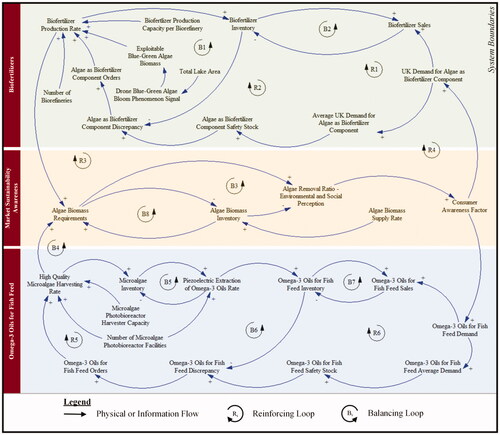
The System Dynamics approach involves the transformation of the developed causal loop diagram into a dynamic simulation model. The structural elements of the model include stock variables (represented by rectangles), flow variables (represented by valves), time delays (represented by marked lines), auxiliary variables (represented by circles), and constants (represented by diamonds). The continuous nature of the simulation is attributed to the integral equations underpinning the structure of the model to express the accumulation of flow variables in stocks.
The System Dynamics simulation model was developed using the Powersim® Studio 10 Academic software package. We set a strategic time horizon of five years while we selected a time step of a month. in Appendix II summarises the mathematical formulation that justifies the System Dynamics simulation model. The stock and flow diagram of the circular supply network system under study is depicted in .
5.2.2. Network and unit operations modelling (meso- and micro-levels)
The network simulation model was formulated, optimised, analysed and visualised using Llamasoft Supply Chain Guru®, a software tool that requires understanding over the required data inputs and user interface. The advantages of the tool specifically apply in the optimisation capabilities (Bassett Citation2018).
The fundamental elements of the developed network simulation model include: (i) products – five (i.e., surface wastewater; algae biomass for biofertilisers; microalgae biomass for omega-3 oils; omega-3 oils for fish feed; biofertiliser); (ii) supply, manufacturing and retail/consumption sites – variable number depending on the scenario (i.e., five lakes; two or three biofertilisers production plants; one or two omega-3 oils production plants; nine wheat farms; twenty-five fish farms); (iii) demand in wheat and fish farms; (iv) sourcing policies; (v) transportation policies; and (vi) inventory policies. The coordinates of the biofertilisers and omega-3 oils manufacturing plants were generated by leveraging the principles of the centre of gravity method applied to the location of the considered UK lakes and wheat and fish farms, respectively. The coordinates of actual wheat and fish farms were retrieved from secondary sources.
6. Results and discussion
In this section, we first summarise the findings of the critical taxonomy and propose a hierarchical decision-making process framework. We then insert the simulation modelling and optimisation results in terms of the examined real-world case.
6.1. Decision-making process
The hierarchical decision-making process clearly depicts the multi-dimensional, yet unexplored, domain of circular supply chains enabled by Industry 4.0. Specifically, at a strategic level, it is vital that a vision and industrial/corporate expectations of Industry 4.0 applications are set in terms of the circularity of wasted/discarded products and renewable materials at the post-consumption stage. In addition, interfaces that enable the synergy between the human element and technology is essential to ensure a high adoption rate of Industry 4.0 in operations.
At tactical and operational levels, extant studies reveal that the monitoring of product-related data across circular supply chains dominates the related decisions. In addition, leveraging existing databases and real-time monitoring of material- and product-centric data, particularly at the supply and consumption echelons, are considered key to the establishment of circular operations in terms of scheduling and quality assurance. To this effect, the involved supply chain stakeholders should mainly agree on the operations to automate and on the structure of the relevant data to be gathered. presents a synopsis of the resulting hierarchical decision-making process.
Table 4. Hierarchical decision-making framework.
6.2. Modelling methodology
We conducted 1,000 simulation runs and network optimisation per each scenario to derive robust results, as summarised in in Appendix II.
6.2.1. System modelling (macro-level)
Evidently, the different scenarios do not appear to have any impact on the inventory position of biofertilisers and omega-3 oils from month 0 to month 6 due to the seasonal appearance of the algal bloom phenomenon. Therefore, the developed model during this initial simulation period resulted in expected behaviour (i.e., zero values) as we did not consider any initial inventory of algae biomass and due to the modelled information and production time delays.
illustrates the dynamic behaviour of the system in terms of ‘Biofertiliser Inventory’. The use of two manufacturing plants results in a stable biofertiliser inventory of about 2.5 tonnes throughout the analysis time horizon. However, due to the prevalence of the reinforcing feedback mechanisms, enabling a third facility leads to significant fluctuations but with lower average inventory during the time horizon of analysis. The production lead time seems to have a negligible effect on the inventory. For high-volume low-value products, like biofertlisers, digital manufacturing does not appear to offer compelling benefits as scale of production appears to be more preferable.
Furthermore, demonstrates the dynamic behaviour of the system in terms of ‘Omega-3 Oils for Fish Feed Inventory’. When one or two digital enabled micro-factories are utilised, with a corresponding number of photobioreactors and piezoelectric transducer equipment, the inventory for omega-3 oils reaches an equilibrium in time, thus facilitating the planning and scheduling of supply network operations. Logically, considering the system under study, the use of two micro-factories raises the omega-3 oils inventory position compared to the use of merely one facility. This stability in inventory is preferable to facilitate the transition towards circular supply networks, probe the market, and demonstrate the feasibility of the emerging manufacturing paradigm.
Markedly, the utilisation of a third production facility causes significant fluctuations in the resulting inventory, a case that is typically not preferable in manufacturing operations. However, as Industry 4.0-enabled supply network operations aim to balance demand and supply, such fluctuations are legitimate and in a future distributed manufacturing landscape would require the appropriate infrastructure to manage. Furthermore, the lead time for the production of omega-3 oils only slightly appears to affect the inventory development time by about two or three months. From a circular supply network design perspective, low-volume high-value products like omega-3 oils can benefit from digital and continuous manufacturing by enabling distributed production near to markets and via allowing flexible production and inventory control, based on the demand patterns and availability of the renewable feedstock. Digital technologies allow the just-in-time response to demand while contemporarily adjusting production intensity to minimise inventory costs.
Additionally, presents the dynamic behaviour of the system in terms of ‘Biofertilizer Lost Sales’. The increased demand for biofertilisers leads to the same trend in lost sales for all scenarios. Utilising digital-enabled large-scale manufacturing facilities for such high-volume products, particularly considering the seasonality of crops and associated needs for fertilisers, requires significant continuous manufacturing capacity in the future.
Moreover, depicts the dynamic behaviour of the system in terms of ‘Omega-3 Oils for Fish Feed Lost Sales’. The implementation of three production facilities reduces lost sales with the greater lead time smoothing the observed fluctuations. From a supply network design perspective, low-volume high-value products might imply the use of multiple digital micro-factories to limit lost sales and outperform operating costs through sales and profits (Grima et al. Citation2003). The fluctuations in lost sales further reflect the seasonal availability of algal blooms, which are considered the renewable feedstock source. In terms of the impact of ‘green’ market behaviour of environmentally sensitive consumers, the initialisation of the Circular Economy 4.0 operations triggers the environmental sensitivity of the market thus abruptly increasing demand and subsequent lost sales, subject to the considered capacity constraints.
6.2.2. Network and unit operations modelling (meso- and micro-levels)
The optimised network configurations for the examined scenarios, objective function (maximise profit) and time horizon (5-year period) are illustrated in . The optimised network configurations demonstrate the balance needed between the availability of renewable feedstock, number of manufacturing facilities, and transportation requirements.
On the one hand, in the first scenario (i.e., ‘Biorefineries: 2; Microalgae Photobioreactor Facilities: 1’) most markets are remote, hence requiring intensive distribution operations. The use of a few large-scale manufacturing facilities typically increases lead time to markets along with requirements for transportation assets and associated costs. Such a centralised configuration serves standardised products that are manufactured in batches and are typically of low value. On the other hand, in the last scenario (i.e., ‘Biorefineries: 3; Microalgae Photobioreactor Facilities: 3’) manufacturing facilities are distributed and located closer to markets, thus requiring less transportation but more capital expenditure that needs to be balanced by meticulously planning the installed production capacity. Such a decentralised configuration is appropriate for high-value products that could be manufactured in a continuous mode and might require customised/personalised attributes. Additionally, in the last scenario (i.e., ‘Biorefineries: 3; Microalgae Photobioreactor Facilities: 3’) the increased production capacity reduces the ‘Microalgae Biomass for Omega-3 Oils’ inventory by more than 90%, hence eliminating inventory costs.
Digitalisation is appropriate for enabling decentralised and distributed manufacturing for serving high-value markets and providing enhanced customisation/personalisation. Considering the use of renewable feedstocks and the possible degradation of its physico-chemical properties, primary processing facilities should be placed adjacent to the feedstock supply sources. This affinity further provides the circular supply network with resilience and flexibility to respond to both supply and demand fluctuations.
Finally, the optimised routing of the drone for signalling the initialisation of manufacturing operations, from the biofertilisers manufacturing sites to the targeted lakes, is presented in . The routing of the drone assists in monitoring the availability of the renewable feedstock, hence informing manufacturing operations by adjusting production scheduling and rates accordingly. This interplay between Circular Economy and Industry 4.0 enables the design and management of manufacturing supply network operations from the feedstock perspective (Srai et al. Citation2018).
6.3. Digital-enabled circular supply network design principles
The findings of this research, enabled through a mixed-methods approach, led to the articulation of four principles on the design of circular supply networks enabled by Industry 4.0 applications, as summarised in . In a Circular Economy context, Industry 4.0 applications can impact the configurational design of the respective supply chains, e.g., centralised – semi-centralised – decentralised, particularly in terms of the utilised feedstock valorisation and intermediate/end-products manufacturing sites, and manufacturing throughput time. The operational ramifications of the emerging configurational designs are mainly associated with transportation distance, inventory position per site, and lost sales.
Table 5. Design principles on circular supply networks enabled by Industry 4.0 applications.
7. Conclusions
The interplay between Circular Economy and Industry 4.0 triggers the emergence of unique types of digital supply network configurational designs which could be characterised by decentralisation, enhanced resources’ utilisation efficiency, and market responsiveness. However, current perspectives in this emerging research domain – we refer to this space as ‘Circular Economy 4.0’ – are limited and largely descriptive. As a consequence, these are also limited in terms of practical relevance. To this end, this research studied the interplay between circular supply chains and Industry 4.0, proposing: (i) a framework capturing the interplay between Circular Economy and Industry 4.0 towards sustainable supply chains; (ii) an inclusive hierarchical decision-making process applicable to all stakeholders involved in the design and management of digital-enabled circular networks; and (iii) a multi-level simulation modelling and optimisation approach for the configuration and performance assessment of circular supply systems enabled by Industry 4.0 technologies.
Exploring key gaps and themes in the academic and practice literature led to the formulation of three questions of research interest. In approaching RQ#1, a framework was developed that captures the interplay between Circular Economy and Industry 4.0 concepts via a synthesis of pertinent research evidence. In terms of RQ#2, a critical taxonomy of the extant literature was conducted that resulted in an integrated hierarchical decision-support process for the design and management of digital-enabled sustainable supply network operations. In terms of RQ#3, a multi-level simulation modelling and optimisation approach was applied that investigated alternative network designs in the context of integrating circularity of materials, operations efficiency, product quality and customer satisfaction.
7.1. Theoretical contributions
This research demonstrates that to realise the interplay between Circular Economy and Industry 4.0 within a supply chain context, the incorporation of selected digital technologies is required at network and unit operations levels to enable system integration, collaboration and resource productivity. This aligns with the theoretical findings of Fatorachian and Kazemi (Citation2018). Specifically, this research proposed a research framework that captures the interplay between Circular Economy and Industry 4.0 towards sustainable supply chains. Furthermore, this study provided a critical taxonomy of the extant literature; the taxonomy findings confirmed the observation of Tseng et al. (Citation2018) who stressed the limited number of peer-reviewed scientific publications investigating the interplay between Circular Economy and Industry 4.0. In addition, this research applied a multi-level simulation modelling and optimisation approach to demonstrate the implications of renewable feedstocks in the design of circular supply networks via investigating a real-world case. Therefore, this research contributes to the second stage of the roadmap developed by de Sousa Jabbour, Jabbour, Filho, et al. (Citation2018) in terms of providing a methodological approach to assess Industry 4.0 technologies within a Circular Economy context so as to inform decisions valid to sustainable operations management.
Theoretical and modelling outputs of this research could be used to address the performance assessment challenge that governs sustainable supply networks (Bhattacharya et al. Citation2014). Furthermore, the decision-making approach outlined in this research can be used to differentiate pre-/post-implementation criteria to enable evaluation and re-evaluation phases, e.g., linking theoretical performance of solutions in the design stage with real-world performance in post-implementation stages for use cases. The richness of data demonstrated here may enable more informed correlations and, therefore, improvements in quality of evaluation criteria in Circular Economy solution designs.
7.2. Managerial and social implications
Based on our discussions with key stakeholders (i.e., industrialists, policy-makers, entrepreneurs and academics), we argue that many Circular Economy 4.0-type operational initiatives will fail to proceed to the implementation stage because the supply network benefits accruing may not be effectively (or correctly) evaluated from an end-to-end perspective. Hence, a key goal is that the proposed decision-making approach developed here be utilised by managers to obtain better estimates on end-to-end system performance for promising circular supply network designs enabled by Industry 4.0 implementations. In summary, this research provides practical guidance for organisations on Circular Economy 4.0 principles that can be used in designing their next-generation ‘digitalised’ supply networks. Through a conceptual framework development and its application using a real-world demonstrator, this study contributes in a number of ways, for example:
While previous studies and modelling efforts have largely focussed at production and plant levels, they often lack a formal end-to-end network assessment. This research now provides industrialists with a better understanding of the various challenges/barriers for the successful transition to the circular economy era, from digital supply network design and configuration perspectives.
From a managerial perspective, this research demonstrates an indicative Industry 4.0 operational structure within a Circular Economy context. Here, outputs from implementation of the in-depth demonstrator case provide valuable supporting decision-making evidence in terms of business context/viability, social impact, and supply network (re)configuration opportunities. Furthermore, this enables supply network designers and technology developers/providers to better understand alternative scenarios from a societal needs and end-to-end supply network perspectives, and to then pursue appropriate business models.
As well as enabling operations managers to evaluate performance implications of alternative service offerings – driven by the adoption of the ‘Circular Economy 4.0’ principles – the applied multi-level modelling approach can be utilised to provide differentiation between pre-/post-implementation criteria as per Section 7.1. This decision-making capability enables evaluation and re-evaluation at different stages, i.e., linking performance of a solution in the design stage, with real-world performance in post-implementation stages of an initiative.
In enabling this correlation at various stages, the applied multi-level modelling approach may be used as an investigational tool through use of its strategic, operational and tactical decision-making variables. As well as promoting evaluation quality in design and redesign stages, the proposed design principles provide managers with a basis for future benchmarking of network activities enabled by Industry 4.0 applications. Here, current state configurations may be evaluated against future desired state(s) in terms of, e.g., resource utilisation and market dynamics.
7.3. Limitations
This research may serve as a starting point for informing supply network designers, technology developers, manufacturers and service providers in their development of the next generation of sustainable supply networks (i.e., flexible, agile, adaptive and efficient). However, in short, there are two primary limitations to this study. First, the determinants of successful transition in Circular Economy-Industry 4.0 network contexts were explored through the use of one case study. Hence, additional validation with a more extensive set of ‘Circular Economy 4.0’-specific cases would be beneficial. Secondly, this research did not focus on the exhaustive quantification of all the Industry 4.0 related challenges, as suggested by Luthra and Mangla (Citation2018); however, this presents extensive and interesting opportunities for future research. Specifically, this quantification will serve to inform selection criteria in identifying follow-on studies, e.g., in targeting cases around digitalisation, personalisation, and localisation (as per Kumar et al. Citation2020).
7.4. Future research
In the future, with reference to the United Nations Sustainable Development Goals (e.g., Sustainable Development Goal 6 – ‘Clean Water and Sanitation’), we envisage the development of models leveraging the interplay between Circular Economy and Industry 4.0 to provide insights to policy-makers and entrepreneurs on the valorisation of wasted renewable feedstocks (Mangla, Bhattacharya, and Luthra Citation2018). Particularly, in order to increase the generalisability of our research, we aim to expand our modelling focus to the case of terpenes, a class of naturally occurring chemical compounds with unexplored potential for the fine chemicals industry, through leveraging extant efforts on mapping the sector (Tsolakis et al. Citation2019). In addition, future studies will examine social (e.g., ecological health) as well as economic impacts and how digital technologies and societal needs may influence future operating philosophies.
Moreover, we aim to explore policies that may facilitate a region’s ability to adapt and transition towards a ‘Circular Economy 4.0’ context. In an industrial context, we expect to inform distributed manufacturing strategies (Kumar et al. Citation2020) so firms leverage existing renewable feedstocks, available as untreated/unexploited waste in particular sectors, to establish circular supply network operations in other value-added fields.
Additional information
Funding
Notes on contributors

Naoum Tsolakis
Dr Naoum Tsolakis is a Research Associate in Industrial Systems and Network Analysis at the Department of Engineering, University of Cambridge, where he focusses on the design, analysis and management of multi-level operations in sustainable supply network systems. More specifically, his main research and practice interests include the areas of simulation modelling and optimisation of end-to-end supply chain operations, enabled by digital technologies, to assess emerging configurational designs for the efficient management of industrial manufacturing networks. He holds a 5-year Engineering Diploma (top graduate for the Academic Year 2005–2006) and a PhD degree in Mechanical Engineering, along with four Masters degrees in the engineering and business management domains.

Tomás Seosamh Harrington
Dr Tomás Seosamh Harrington is an Associate Professor in Digitalisation and Operations Management at the University of East Anglia. He is a co-Investigator on the TIGR2ESS supply chain flagship project which is supported by the BBSRC/RCUK Global Challenges Research Fund (GCRF), while his research focuses on industrial systems transformation enabled by the adoption of advanced manufacturing and digital technologies. Previous senior roles in industry have encompassed new product development, process design, and big data analytics – most recently with Intel Corporation. He holds Bachelor’s and PhD degrees (Chemistry), and an MBA (distinction) for which he received a Chartered Management Institute Award in 2008.
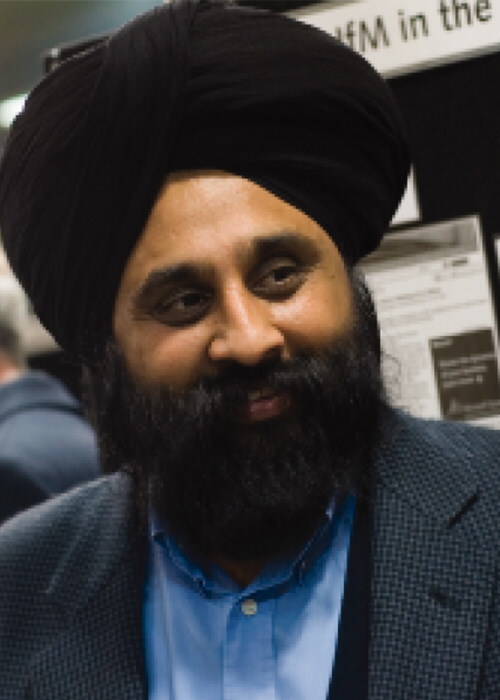
Jagjit Singh Srai
Dr Jagjit Singh Srai is Head of the Centre for International Manufacturing, Institute for Manufacturing, University of Cambridge. He has Director/Investigator roles across several major multi-disciplinary research projects, bringing an engineering and strategic operations management perspective to the design, analysis and operation of international supply chains. Research projects explore the disruptive impacts of new production and digital technologies on supply chains, markets and regulation, involving close collaborations with industry, academia, and public bodies. Jag also advises leading multinationals, governments and international institutions including UNCTAD, UNIDO, WEF. Previous roles were in industry with Unilever working as a Supply Chain Director of a multinational regional business, Technical Director of a national business and other senior management positions. He holds a first-class honours degree in Chemical Engineering from Aston University, MPhil and PhD degrees in International Supply Networks from Cambridge University, is a Chartered Engineer and a Fellow of the Institute of Chemical Engineers.
References
- AIC Statistics. 2017. Fertiliser Statistics 2017. Peterborough: Agricultural Industries Confederation.
- Aivazidou, E., N. Tsolakis, D. Vlachos, and E. Iakovou. 2018. “A Water Footprint Management Framework for Supply Chains under Green Market Behaviour.” Journal of Cleaner Production 197 (Part 1): 592–606. doi:10.1016/j.jclepro.2018.06.171.
- Allaoui, H., Y. Guo, A. Choudhary, and J. Bloemhof. 2018. “Sustainable Agro-Food Supply Chain Design Using Two-Stage Hybrid Multi-Objective Decision-Making Approach.” Computers & Operations Research 89: 369–384. doi:10.1016/j.cor.2016.10.012.
- Artz, J., and R. Palkovits. 2018. “Cellulose-Based Platform Chemical: The Path to Application.” Current Opinion in Green and Sustainable Chemistry 14: 14–18. 18. doi:10.1016/j.cogsc.2018.05.005.
- Bag, S., L. C. Wood, S. K. Mangla, and S. Luthra. 2020. “Procurement 4.0 and Its Implications on Business Process Performance in a Circular Economy.” Resources, Conservation and Recycling 152: 104502. doi:10.1016/j.resconrec.2019.104502.
- Balci, O. 1998. “Verification, Validation and Testing.” In Handbook of Simulation: Principles, Methodology, Advances, Applications, and Practice, edited by Jerry Banks, 335–393. New York: John Wiley & Sons.
- Banks, J., S. Carson II, B. L. Nelson, and D. M. Nicol. 2009. Discrete-Event System Simulation: International Edition. Essex: Pearson.
- Bassett, M. 2018. “Optimizing the Design of New and Existing Supply Chains at Dow AgroSciences.” Computers & Chemical Engineering 114: 191–200. doi:10.1016/j.compchemeng.2018.03.012.
- Bechtsis, D., N. Tsolakis, D. Vlachos, and E. Iakovou. 2017. “Sustainable Supply Chain Management in the Digitalisation Era: The Impact of Automated Guided Vehicles.” Journal of Cleaner Production 142 (Part 4): 3970–3984. doi:10.1016/j.jclepro.2016.10.057.
- Bechtsis, D., N. Tsolakis, D. Vlachos, and J. S. Srai. 2018. “Intelligent Autonomous Vehicles in Digital Supply Chains: A Framework for Integrating Innovations towards Sustainable Value Networks.” Journal of Cleaner Production 181: 60–71. doi:10.1016/j.jclepro.2018.01.173.
- Belaud, J.-P., N. Prioux, C. Vialle, and C. Sablayrolles. 2019. “Big Data for Agri-Food 4.0: Application to Sustainability Management for by-Products Supply Chain.” Computers in Industry 111: 41–50. doi:10.1016/j.compind.2019.06.006.
- Bhattacharya, A., P. Mohapatra, V. Kumar, P. K. Dey, M. Brady, M. K. Tiwari, and S. S. Nudurupati. 2014. “Green Supply Chain Performance Measurement Using Fuzzy ANP-Based Balanced Scorecard: A Collaborative Decision-Making Approach.” Production Planning & Control 25 (8): 698–714. doi:10.1080/09537287.2013.798088.
- Binding, C. E., T. A. Greenberg, G. McCullough, S. B. Watson, and E. Page. 2018. “An Analysis of Satellite-Derived Chlorophyll and Algal Bloom Indices on Lake Winnipeg.” Journal of Great Lakes Research 44 (3): 436–446. doi:10.1016/j.jglr.2018.04.001.
- Bio-FIT. 2017. “Bio-Fertilisers towards Sustainable Agriculture – Bio-Fertilisers Marker Share.” Bio-FIT Project, December 2017. Accessed 16 November 2018. https://www.bio-fit.eu/upload/Bio-Fit-Book/EN/LO_12.pdf.
- Bourne, D. G., R. L. Blakeley, P. Riddles, and G. J. Jones. 2006. “Biodegradation of the Cyanobacterial Toxin Microcystin LR in Natural Water and Biologically Active Slow Sand Filters.” Water Research 40 (6): 1294–1302. doi:10.1016/j.watres.2006.01.022.
- Branigan, T. 2008. “Chinese Race to Clear Algae from Olympic Sailing Venue.” The Guardian, June 30, 2008. Accessed 16 November 2018. https://www.theguardian.com/environment/2008/jun/30/pollution.olympicgames2008.
- Bressanelli, G., F. Adrodegari, M. Perona, and N. Saccani. 2018. “Exploring How Usage-Focused Business Models Enable Circular Economy through Digital Technologies.” Sustainability 10 (3): 639. doi:10.3390/su10030639.
- Calvo, G., A. Valero, and A. Valero. 2017. “Assessing Maximum Production Peak and Resource Availability of Non-Fuel Mineral Resources: Analyzing the Influence of Extractable Global Resources.” Resources, Conservation and Recycling 125: 208–217. doi:10.1016/j.resconrec.2017.06.009.
- Cezarino, L. O., L. B. Liboni, N. Oliveira Stefanelli, B. G. Oliveira, and L. C. Stocco. 2021. “Diving into Emerging Economies Bottleneck: Industry 4.0 and Implications for Circular Economy.” Management Decision 59 (8): 1841–1862. Article In Press. doi:10.1108/MD-10-2018-1084.
- Chatfield, D. C., T. P. Harrison, and J. C. Hayya. 2006. “SISCO: An Object-Oriented Supply Chain Simulation System.” Decision Support Systems 42 (1): 422–434. doi:10.1016/j.dss.2005.02.002.
- Concas, A., V. Malavasi, C. Costelli, P. Fadda, M. Pisu, and G. Cao. 2016. “Autotrophic Growth and Lipid Production of Chlorella Sorokiniana in Lab Batch and BIOCOIL Photobioreactors: Experiments and Modelling.” Bioresource Technology 211: 327–338. doi:10.1016/j.biortech.2016.03.089.
- Dallasega, P., E. Rauch, and C. Linder. 2018. “Industry 4.0 as an Enabler of Proximity for Construction Supply Chains: A Systematic Literature Review.” Computers in Industry 99: 205–225. doi:10.1016/j.compind.2018.03.039.
- Daú, G., A. Scavarda, L. F. Scavarda, and V. J. T. Portugal. 2019. “The Healthcare Sustainable Supply Chain 4.0: The Circular Economy Transition Conceptual Framework with the Corporate Social Responsibility Mirror.” Sustainability 11 (12): 3259. doi:10.3390/su11123259.
- De Angelis, R., M. Howard, and J. Miemczyk. 2018. “Supply Chain Management and the Circular Economy: Towards the Circular Supply Chain.” Production Planning & Control 29 (6): 425–437. doi:10.1080/09537287.2018.1449244.
- de Sousa Jabbour, A. B. L., C. J. C. Jabbour, M. G. Filho, and D. Roubaud. 2018. “Industry 4.0 and the Circular Economy: A Proposed Research Agenda and Original Roadmap for Sustainable Operations.” Annals of Operations Research 270 (1–2): 273–286. doi:10.1007/s10479-018-2772-8.
- de Sousa Jabbour, A. B. L., C. J. C. Jabbour, C. Foropon, and M. G. Filho. 2018. “When Titans Meet – Can Industry 4.0 Revolutionise the Environmentally-Sustainable Manufacturing Wave? The Role of Critical Success Factors.” Technological Forecasting and Social Change 132: 18–25. doi:10.1016/j.techfore.2018.01.017.
- Department for Environment, Food and Rural Affairs. 2018. “Farming Statistics: Provisional Crop Areas, Yields and Livestock Populations (At June 2018 – United Kingdom).” Department for Environment, Food and Rural Affairs, October 2018. Accessed 16 October 2018. https://assets.publishing.service.gov.uk/government/uploads/system/uploads/attachment_data/file/747210/structure-jun2018prov-UK-11oct18.pdf.
- Dev, N. K., R. Shankar, and F. H. Qaiser. 2020. “Industry 4.0 and Circular Economy: Operational Excellence for Sustainable Reverse Supply Chain Performance.” Resources, Conservation and Recycling 153: 104583. doi:10.1016/j.resconrec.2019.104583.
- EC. 2015. Circular Economy Package: Questions and Answers. Brussels: European Commission. Accessed 16 October 2018. https://ec.europa.eu/commission/presscorner/detail/en/MEMO_15_6204.
- Ellen MacArthur Foundation. 2015. Towards a Circular Economy: Business Rationale for an Accelerated Transition. Cowes: Ellen MacArthur Foundation.
- Ellen MacArthur Foundation. 2019. Completing the Picture: How the Circular Economy Tackles Climate Change. Cowes: Ellen MacArthur Foundation.
- ExxonMobil. 2015. Summary Annual Report 2015. Irving: Exxon Mobil Corporation.
- Fatorachian, H., and H. Kazemi. 2018. “A Critical Investigation of Industry 4.0 in Manufacturing: Theoretical Operationalisation Framework.” Production Planning & Control 29 (8): 633–644. doi:10.1080/09537287.2018.1424960.
- Garrido-Hidalgo, C., T. Olivares, F. J. Ramirez, and L. Roda-Sanchez. 2019. “An End-to-End Internet of Things Solution for Reverse Supply Chain Management in Industry 4.0.” Computers in Industry 112: 103127. doi:10.1016/j.compind.2019.103127.
- Geissdoerfer, M., P. Savaget, N. M. P. Bocken, and E. J. Hultink. 2017. “The Circular Economy – A New Sustainability Paradigm?” Journal of Cleaner Production 143: 757–768. doi:10.1016/j.jclepro.2016.12.048.
- Graves, A. R., J. Morris, L. K. Deeks, R. J. Rickson, M. G. Kibblewhite, J. A. Harris, T. S. Farewell, and I. Truckle. 2015. “The Total Costs of Soil Degradation in England and Wales.” Ecological Economics 119: 399–413. doi:10.1016/j.ecolecon.2015.07.026.
- Grima, E. M., E.-H. Belarbi, F. G. Acién Fernández, A. Robles Medina, and Yusuf Chisti. 2003. “Recovery of Microalgal Biomass and Metabolites: Process Options and Economics.” Biotechnology Advances 20 (7–8): 491–515. doi:10.1016/S0734-9750(02)00050-2.
- Harrington, T. S., N. R. Joglekar, and J. S. Srai. 2018. “Digitalisation of Development and Supply Networks: Sequential and Platform-Driven Innovations.” SSRN Working paper, August 25. Available at SSRN: https://ssrn.com/abstract=3238907.
- Harrington, T. S., and J. S. Srai. 2012. “Defining Product-Service Network Configurations and Location Roles: A Current and Future State Analysis Framework for International Engineering Operations.” International Journal of Product Development 17 (3/4): 228–253. doi:10.1504/IJPD.2012.052103.
- Hofmann, E., and M. Rüsch. 2017. “Industry 4.0 and the Current Status as Well as Future Prospects on Logistics.” Computers in Industry 89: 23–34. doi:10.1016/j.compind.2017.04.002.
- Hu, Z., Y. Zheng, F. Yan, B. Xiao, and S. Liu. 2013. “Bio-Oil Production through Pyrolysis of Blue-Green Algae Blooms (BGAB): Product Distribution and Bio-Oil Characterization.” Energy 52: 119–125. doi:10.1016/j.energy.2013.01.059.
- Jensen, J. P., and A. Remmen. 2017. “Enabling Circular Economy through Product Stewardship.” Procedia Manufacturing 8: 377–384. doi:10.1016/j.promfg.2017.02.048.
- Joint Nature Conservation Committee. 2018. “B7. Surface Water Status.” Joint Nature Conservation Committee, July 2018. Accessed 16 October 2018. http://jncc.defra.gov.uk/pdf/UKBI2018_F_B7.pdf.
- Kamble, S. S., A. Gunasekaran, and S. A. Gawankar. 2018. “Sustainable Industry 4.0 Framework: A Systematic Literature Review Identifying the Current Trends and Future Perspectives.” Process Safety and Environmental Protection 117: 408–425. doi:10.1016/j.psep.2018.05.009.
- Kouhizadeh, M., Q. Zhu, and J. Sarkis. 2020. “Blockchain and the Circular Economy: Potential Tensions and Critical Reflections from Practice.” Production Planning and Control 31: 950–966. doi:10.1080/09537287.2019.1695925.
- Kumar, M., N. Tsolakis, A. Agarwal, and J. S. Srai. 2020. “Developing Distributed Manufacturing Strategies from the Perspective of a Product-Process Matrix.” International Journal of Production Economics 219: 1–17. doi:10.1016/j.ijpe.2019.05.005.
- Lapkin, A. A., P. K. Heer, P.-M. Jacob, M. Hutchby, W. Cunningham, S. D. Bull, and M. G. Davidson. 2017. “Automation of Route Identification and Optimisation Based on Data-Mining and Chemical Intuition.” Faraday Discussions 202: 483–496. doi:10.1039/c7fd00073a.
- Liao, Y., F. Deschamps, E. F. R. Loures, and L. F. P. Ramos. 2017. “Past, Present and Future of Industry 4.0 – A Systematic Literature Review and Research Agenda Proposal.” International Journal of Production Research 55 (12): 3609–3629. doi:10.1080/00207543.2017.1308576.
- Lieder, M., and A. Rashid. 2016. “Towards Circular Economy Implementation: A Comprehensive Review in Context of Manufacturing Industry.” Journal of Cleaner Production 115: 36–51. doi:10.1016/j.jclepro.2015.12.042.
- Lin, K.-Y. 2018. “User Experience-Based Product Design for Smart Production to Empower Industry 4.0 in the Glass Recycling Circular Economy.” Computers & Industrial Engineering 125: 729–738. doi:10.1016/j.cie.2018.06.023.
- Luthra, S., and S. K. Mangla. 2018. “Evaluating Challenges to Industry 4.0 Initiatives for Supply Chain Sustainability in Emerging Economies.” Process Safety and Environmental Protection 117: 168–179. doi:10.1016/j.psep.2018.04.018.
- Luthra, S., S. K. Mangla, R. Shankar, C. P. Garg, and S. Jakhar. 2018. “Modelling Critical Success Factors for Sustainability Initiatives in Supply Chains in Indian Context Using Grey-DEMATEL.” Production Planning & Control 29 (9): 705–728. doi:10.1080/09537287.2018.1448126.
- Lyons, A. C., J. Um, and H. Sharifi. 2020. “Product Variety, Customisation and Business Process Performance: A Mixed-Methods Approach to Understanding Their Relationships.” International Journal of Production Economics 221: 107469. doi:10.1016/j.ijpe.2019.08.004.
- Manataki, A., Y.-H. Chen-Burger, and M. Rovatsos. 2014. “SCOlog: A Logic-Based Approach to Analysing Supply Chain Operation Dynamics.” Expert Systems with Applications 41 (1): 23–38. doi:10.1016/j.eswa.2013.07.008.
- Mangla, S. K., A. Bhattacharya, and S. Luthra. 2018. “Achieving Sustainability in Supply Chain Operations in the Interplay between Circular Economy and Industry 4.0.” Production Planning and Control. https://pearl.plymouth.ac.uk/bitstream/handle/10026.1/11623/PPC_SI_CfP_Revised_FINAL.docx?sequence=1&isAllowed=y
- Mangla, S. K., S. Luthra, N. Mishra, A. Singh, N. P. Rana, M. Dora, and Y. Dwivedi. 2018. “Barriers to Effective Circular Supply Chain Management in a Developing Country Context.” Production Planning & Control 29 (6): 551–569. doi:10.1080/09537287.2018.1449265.
- Mangla, S. K., S. Luthra, N. Rich, D. Kumar, N. P. Rana, and Y. K. Dwivedi. 2018. “Enablers to Implement Sustainable Initiatives in Agri-Food Supply Chains.” International Journal of Production Economics 203: 379–393. doi:10.1016/j.ijpe.2018.07.012.
- Mangla, S. K., J. Madaan, and F. T. S. Chan. 2013. “Analysis of Flexible Decision Strategies for Sustainability-Focused Green Product Recovery System.” International Journal of Production Research 51 (11): 3428–3442. doi:10.1080/00207543.2013.774493.
- Marine Management Organisation 2015. “UK Sea Fisheries Statistics 2014.” Office for National Statistics. Accessed 16 October 2018. https://assets.publishing.service.gov.uk/government/uploads/system/uploads/attachment_data/file/598190/UK_Sea_Fisheries_Statistics_2014_full_report.pdf.
- Marques, M., C. Agostinho, G. Zacharewicz, and R. Jardim-Gonçalves. 2017. “Decentralized Decision Support for Intelligent Manufacturing in Industry 4.0.” Journal of Ambient Intelligence and Smart Environments 9 (3): 299–313. doi:10.3233/AIS-170436.
- Martín-Gómez, A., F. Aguayo-González, and A. Luque. 2019. “A Holonic Framework for Managing the Sustainable Supply Chain in Emerging Economies with Smart Connected Metabolism.” Resources, Conservation and Recycling 141: 219–232. doi:10.1016/j.resconrec.2018.10.035.
- Mongeon, P., and A. Paul-Hus. 2016. “The Journal Coverage of Web of Science and Scopus: A Comparative Analysis.” Scientometrics 106 (1): 213–228. doi:10.1007/s11192-015-1765-5.
- Moorhouse, H. L., D. S. Read, S. McGowan, M. Wagner, C. Roberts, L. K. Armstrong, D. J. E. Nicholls, H. D. Wickham, M. G. Hutchins, and M. J. Bowes. 2018. “Characterisation of a Major Phytoplankton Bloom in the River Thames (UK) Using Flow Cytometry and High Performance Liquid Chromatography.” The Science of the Total Environment 624: 366–376. doi:10.1016/j.scitotenv.2017.12.128.
- Nascimento, D. L. M., V. Alencastro, O. L. G. Quelhas, R. G. G. Caiado, J. A. Garza-Reyes, L. R. Lona, and G. Tortorella. 2019. “Exploring Industry 4.0 Technologies to Enable Circular Economy Practices in a Manufacturing Context: A Business Model Proposal.” Journal of Manufacturing Technology Management 30 (3): 607–627. doi:10.1108/JMTM-03-2018-0071.
- Nasir, M. H. A., A. Genovese, A. A. Acquaye, S. C. L. Koh, and F. Yamoah. 2017. “Comparing Linear and Circular Supply Chains: A Case Study from the Construction Industry.” International Journal of Production Economics 183 (Part B): 443–457. doi:10.1016/j.ijpe.2016.06.008.
- Nobre, G. C., and E. Tavares. 2017. “Scientific Literature Analysis on Big Data and Internet of Things Applications on Circular Economy: A Bibliometric Study.” Scientometrics 111 (1): 463–492. doi:10.1007/s11192-017-2281-6.
- Pankratz, S., A. O. Oyedun, X. Zhang, and A. Kumar. 2017. “Algae Production Platforms for Canada’s Northern Climate.” Renewable and Sustainable Energy Reviews 80: 109–120. doi:10.1016/j.rser.2017.05.220.
- Pinkstone, J. 2018. “Heatwave Causes Build-up of Deadly Blue-green Algae in British Lakes: Waters Infected with Toxic Bacteria can Kill Dogs and Cause Brain Damage in Humans, Experts Warn.” MailOnline, July 2018. Accessed 16 October 2018. https://www.dailymail.co.uk/sciencetech/article-5974419/Heatwave-causes-build-deadly-algae-British-lakes.html.
- Rajput, S., and S. P. Singh. 2019. “Connecting Circular Economy and Industry 4.0.” International Journal of Information Management 49: 98–113. doi:10.1016/j.ijinfomgt.2019.03.002.
- Rejikumar, G., V. Raja Sreedharan, P. Arunprasad, J. Persis, and K. M. Sreeraj. 2019. “Industry 4.0: Key Findings and Analysis from the Literature Arena.” Benchmarking: An International Journal 26 (8): 2514–2542. doi:10.1108/BIJ-09-2018-0281.
- Rosa, P., C. Sassanelli, A. Urbinati, D. Chiaroni, and S. Terzi. 2020. “Assessing Relations between Circular Economy and Industry 4.0: A Systematic Literature Review.” International Journal of Production Research 58 (6): 1662–1687. doi:10.1080/00207543.2019.1680896.
- Shepherd, C. J., O. Monroig, and D. R. Tocher. 2017. “Future Availability of Raw Materials for Salmon Feeds and Supply Chain Implications: The Case of Scottish Farmed Salmon.” Aquaculture 467: 49–62. doi:10.1016/j.aquaculture.2016.08.021.
- Sivakumar, K., R. Jeyapaul, K. E. K. Vimal, and P. Ravi. 2018. “A DEMATEL Approach for Evaluating Barriers for Sustainable End-of-Life Practices.” Journal of Manufacturing Technology Management 29 (6): 1065–1091. doi:10.1108/JMTM-08-2017-0164.
- Soto-Sierra, L., P. Stoykova, and Z. L. Nikolov. 2018. “Extraction and Fractionation of Microalgae-Based Protein Products.” Algal Research 36: 175–192. doi:10.1016/j.algal.2018.10.023.
- Srai, J. S., P. Christodoulou, E. Settanni, T. Harrington, J. Greitemann, M. Kumar, N. Tsolakis, P. Hennelly, N. Trokanas, and P. Beecher. 2017. Next Generation Supply Chains: Making the Right Decision about Digitalisation. Cambridge: Centre for International Manufacturing, Institute for Manufacturing, University of Cambridge.
- Srai, J. S., M. Kumar, G. Graham, W. Phillips, J. Tooze, S. Ford, P. Beecher, et al. 2016. “Distributed Manufacturing: Scope, Challenges and Opportunities.” International Journal of Production Research 54 (23): 6917–6935. doi:10.1080/00207543.2016.1192302.
- Srai, J. S., N. Tsolakis, M. Kumar, and W. Bam. 2018. “Circular Supply Chains and Renewable Chemical Feedstocks: A Network Configuration Analysis Framework.” Production Planning & Control 29 (6): 464–482. doi:10.1080/09537287.2018.1449263.
- Statista. 2017. “Global Omega-3 Supplement Market Size in 2016 and 2025 (in Billion U.S. Dollars).” Statista, May 2017. Accessed 13 November 2018. https://www.statista.com/statistics/758383/omega-3-supplement-market-size-worldwide/.
- Sterman, J. 2000. Business Dynamics: Systems Thinking and Modelling for a Complex World. Boston, MA: McGraw-Hill Higher Education.
- Stiles, W. A. V., D. Styles, S. P. Chapman, S. Esteves, A. Bywater, L. Melville, A. Silkina, et al. 2018. “Using Microalgae in the Circular Economy to Valorise Anaerobic Digestate: Challenges and Opportunities.” Bioresource Technology 267: 732–742. doi:10.1016/j.biortech.2018.07.100.
- Stock, T., M. Obenaus, S. Kunz, and H. Kohl. 2018. “Industry 4.0 as Enabler for a Sustainable Development: A Qualitative Assessment of Its Ecological and Social Potential.” Process Safety and Environmental Protection 118: 254–267. doi:10.1016/j.psep.2018.06.026.
- Struckas, A., P. Vasiljev, R. Bareikis, S. Borodinas, and J. Kasperoviciene. 2017. “Ultrasonic Zeppelin-Shape Transducer for Algae Oil Extraction.” Sensors and Actuators A: Physical 263: 754–761. doi:10.1016/j.sna.2017.05.037.
- Swisher, J. R., S. H. Jacobson, J. B. Jun, and O. Balci. 2001. “Modeling and Analyzing a Physician Clinic Environment Using Discrete-Event (Visual) Simulation.” Computers & Operations Research 28 (2): 105–125. doi:10.1016/S0305-0548(99)00093-3.
- Tripathi, R. D., S. Dwivedi, M. K. Shukla, S. Mishra, S. Srivastava, R. Singh, U. N. Rai, and D. K. Gupta. 2008. “Role of Blue Green Algae Biofertiliser in Ameliorating the Nitrogen Demand and Fly-Ash Stress to the Growth and Yield of Rice (Oryza sativa L.) Plants.” Chemosphere 70 (10): 1919–1929. doi:10.1016/j.chemosphere.2007.07.038.
- Tseng, M.-L., R. R. Tan, A. S. F. Chiu, C.-F. Chien, and T. C. Kuo. 2018. “Circular Economy Meets Industry 4.0: Can Big Data Drive Industrial Symbiosis?” Resources, Conservation and Recycling 131: 146–147. doi:10.1016/j.resconrec.2017.12.028.
- Tsolakis, N., and L. Anthopoulos. 2015. “Eco-Cities: An Integrated System Dynamics Framework and a Concise Research Taxonomy.” Sustainable Cities and Society 17: 1–14. doi:10.1016/j.scs.2015.03.002.
- Tsolakis, N., W. Bam, J. S. Srai, and M. Kumar. 2019. “Renewable Chemical Feedstock Supply Network Design: The Case of Terpenes.” Journal of Cleaner Production 222: 802–822. doi:10.1016/j.jclepro.2019.02.108.
- Tsolakis, N., M. Kumar, and J. S. Srai. 2016. “Exploring Opportunities for Circular Supply Chains Arising from Renewable Chemical Feedstocks.” Keynote papers of the OR58: The OR Society Annual Conference (OR58). Portsmouth University, Portsmouth, United Kingdom, September 6–8.
- Tsolakis, N., and J. S. Srai. 2018. “Mapping Supply Dynamics in Renewable Feedstock Enabled Industries: A Systems Theory Perspective on ‘Green’ Pharmaceuticals.” Operations Management Research 11 (3–4): 83–104. doi:10.1007/s12063-018-0134-y.
- UK Environment Agency. 2018. “Blue Green Algae Remains Present in Four Lake District Locations.” Environment Agency, July 2018. Accessed 16 October 2018. https://www.gov.uk/government/news/blue-green-algae-remains-present-in-four-lake-district-locations.
- United Nations. 2015. Transforming Our World: The 2030 Agenda for Sustainable Development. New York: Division for Sustainable Development Goals, Department of Economic and Social Affairs, United Nations.
- Van Thienen, S., A. Clinton, M. Mahto, and B. Sniderman. 2016. Industry 4.0 and the Chemicals Industry: Catalyzing Transformation through Operations Improvement and Business Growth. New York: Deloitte University Press.
- Wang, Bochao, Séverin Brême, and Young B. Moon. 2014. “Hybrid Modeling and Simulation for Complementing Lifecycle Assessment.” Computers & Industrial Engineering 69: 77–88. doi:10.1016/j.cie.2013.12.016.
- Wang, S., J. Wan, D. Li, and C. Zhang. 2016. “Implementing Smart Factory of Industrie 4.0: An Outlook.” International Journal of Distributed Sensor Networks 12 (1): 3159805. doi:10.1155/2016/3159805.
- World Economic Forum. 2014. Towards the Circular Economy: Accelerating the Scale-up across Global Supply Chains. Cologny/Geneva: World Economic Forum.
- Xu, L. D., E. L. Xu, and L. Li. 2018. “Industry 4.0: State of the Art and Future Trends.” International Journal of Production Research 56 (8): 2941–2962. doi:10.1080/00207543.2018.1444806.
- Yadav, G., S. Luthra, S. K. Jakhar, S. K. Mangla, and D. P. Rai. 2020. “A Framework to Overcome Sustainable Supply Chain Challenges through Solution Measures of Industry 4.0 and Circular Economy: An Automotive Case.” Journal of Cleaner Production 254: 120112. doi:10.1016/j.jclepro.2020.120112.
- Yan, Q., Y. Li, B. Huang, A. Wang, H. Zou, H. Miao, and R. Li. 2012. “Proteomic Profiling of the Acid Tolerance Response (ATR) during the Enhanced Biomethanation Process from Taihu Blue Algae with Butyrate Stress on Anaerobic Sludge.” Journal of Hazardous Materials 235–236: 286–290. doi:10.1016/j.jhazmat.2012.07.062.
- Yang, Shanshan, Aravind M. R, Jacek Kaminski, and Helene Pepin. 2018. “Opportunities for Industry 4.0 to Support Remanufacturing.” Applied Sciences 8 (7): 1177. doi:10.3390/app8071177.
- Zhang, J., A. Babtie, and G. Stephanopoulos. 2012. “Metabolic Engineering: Enabling Technology of a Bio-Based Economy.” Current Opinion in Chemical Engineering 1 (4): 355–362. doi:10.1016/j.coche.2012.09.003.
- Zhang, M., R. Li, L. Cao, J. Shi, H. Liu, Y. Huang, and Q. Shen. 2014. “Algal Sludge from Taihu Lake Can Be Utilized to Create Novel PGPR-containing bio-organic fertilizers.” Journal of Environmental Management 132: 230–236. doi:10.1016/j.jenvman.2013.10.031.
- Zhong, W. Z., Z. Z. Zhang, Y. J. Luo, W. Qiao, M. Xiao, and M. Zhang. 2012. “Biogas Productivity by co-Digesting Taihu Blue Algae with Corn Straw as an External Carbon Source.” Bioresource Technology 114: 281–286. doi:10.1016/j.biortech.2012.02.111.
Appendix I.
System and network description
System modelling (Macro-level)
The ‘Total Lake Area’ of the water bodies defines the ‘Algae Biomass Supply Rate’, under the assumptions of stable algae growth rate and seasonality of the blue-green algae bloom phenomenon. An inspection drone transmits a ‘Drone Blue-Green Algae Bloom Phenomenon Signal’ that informs both the growth of the phenomenon and the initiation of circular supply network operations. The accumulated ‘Algae Biomass Inventory’ then provides the volumes of renewable feedstock.
On one end, the ‘Biofertilizer Production Rate’ is dictated by the ‘Number of Biorefineries’ and the ‘Biofertilizer Production Capacity per Biorefinery’. ‘Biofertilizer Sales’ are defined by the ‘Biofertilizer Inventory’ and the ‘UK Demand for Algae as Biofertilizer Component’ which is further dictated by the ‘Consumer Awareness Factor’. The ‘Consumer Awareness Factor’ is affected by the ‘Algae Removal Ratio – Environmental and Social Perception’ of the consumers about the removal efficiency of blue-green algae from the considered water bodies and expresses the ratio of ‘Algae Biomass Requirements’ to ‘Algae Biomass Inventory’. This perception is inspired by Mangla, Luthra, Rich, et al. (Citation2018), who recognised consumers’ awareness as an enabler of sustainability, and is mathematically captured via the Green Image Factor function used by Aivazidou et al. (Citation2018). The ‘Consumer Awareness Factor’ is expressed as an S-curve function of the blue-green algae removal efficiency (). Actually, a higher blue-green algae removal ratio results in a higher ‘Consumer Awareness Factor’ and vice versa. Processing time, depending on the used continuous manufacturing technologies, and market edge are considered key variables in the recovery process in sustainable supply chains (Mangla, Madaan, and Chan Citation2013).
On the other end, the ‘High Quality Microalgae Harvesting Rate’ is defined by the ‘Number of Microalgae Photobioreactor Facilities’ and the ‘Microalgae Photobioreactor Harvester Capacity’. Thereafter, the accumulated ‘Microalgae Inventory’ along with the ‘Omega-3 Oils Extraction Time’ define the ‘Piezoelectric Extraction of Omega-3 Oils Rate’ which in turn affects the ‘Omega-3 Oils for Fish Feed Inventory’. In particular, the ‘Omega-3 Oils Extraction Time’ depends on the elaborated piezoelectric transducers which comprise a representative Industry 4.0 application as they allow the continuous acoustic harvesting and extraction of omega-3 oils from microalgae biomass. Furthermore, the ‘Omega-3 Oils for Fish Feed Sales’ are dictated by the ‘Omega-3 Oils for Fish Feed Demand’ which is also being affected by the ‘Consumer Awareness Factor’ as in the case of biofertilisers. The required ‘Omega-3 Oils for Fish Feed Safety Stock’ impacts the ‘Omega-3 Oils for Fish Feed Discrepancy’ which further affects the ‘Omega-3 Oils for Fish Feed Orders’.
Network modelling (Meso-level)
A network-level investigation allows the identification of sites and customers, along with a more granular analysis of each individual node in the network in terms of inventory cost. illustrates the network system in the UK where connections are depicted among all appropriate nodes, in line with the underpinning sourcing and transportation policies of intermediate or end-products.
Figure A2. Circular network structure for the supply of biofertilizer and omega-3 oils for fish feed, enabled by algae feedstock, in the UK.
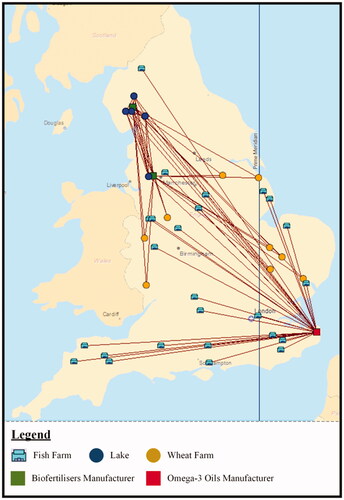
Appendix II.
Systems model development
summarises all feedback loops of the circular supply system under study. In addition, includes the parameters, type of variables, units of measurement and mathematical expressions of the variables governing the circular supply network enabled by algae feedstock. Moreover, provides a summary of the System Dynamics simulation results.
Table A1. Structure of feedback loops of the System Dynamics model.
Table A2. Mathematical formulation of the System Dynamics model.
Table A3. Summary of System Dynamics simulation results.

